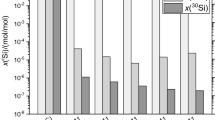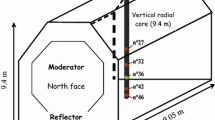Abstract
In the14C-dating by accelerator mass spectrometry (AMS) iron and copper oxide are used during sample preparation. In an investigation on the origin of the14C-blank, which in practice determines the dating limit of AMS, the carbon contamination was measured in both reagents by deuteron activation analysis via the12C(d,n)13N reaction. A first batch of iron was analysed radiochemically and a carbon concentration of 37.6 μg/g was found with a standard deviation of 2.7 μg/g (3 analyses). In a second batch of iron concentrations between 66 and 150 μg/g were found for 6 instrumental analyses, suggesting an inhomogeneous distribution of carbon. The carbon content in copper oxide was 17.8 (3.5) μg/g for 3 instrumental analyses, but preference should be given to a radiochemical analysis. These figures indicate that the carbon impurities found in iron and copper oxide are possible causes of the14C-blank. However, a final conclusion can only be drawn if the14C concentration of the contaminating carbon and the amount of carbon released during sample preparation are known.
Similar content being viewed by others
References
Ch. Engelmann, J. Gosset, C. Grumet, J. Radioanal. Chem., 28 (1975) 185.
Ch. Engelmann, J. Radioanal. Chem., 7 (1971) 89, 281.
C. Vandecasteele, K. Strijckmans, J. Hoste, Anal. Chim. Acta, 108 (1979) 127.
N. Krasnov, P.P. Dmitriyev, S. P. Dmitriyeva, I. O. Konstantinov, G. A. Molin, Uses of Cyclotrons in Chemistry, Metallurgy and Biology,C. B. Amphlett (Ed.), Butterworths, London, 1970.
G. Wauters, C. Vandecasteele, J. Hoste, J. Radioanal. Nucl. Chem., 98 (1986) 345.
J. Cumming, Applications of Computers to Nuclear and Radiochemistry,G. O'Kelley, (Ed.), NAS-NS3107, 1963.
K. Strijckmans, C. Vandecasteele, M. Esprit, Fresenius Z. Anal. Chem., 303 (1980) 106.
G. Slegers, C. Vandecasteele, J. Sambre, J. Radioanal. Chem., 59 (1980) 585.
K. Srijckmans, Chemical Analysis by Nuclear Methods,Z. B. Alfassi (Ed.), J. Wiley, New York, 1994.
R. J. Jaszczak, R. L. Macklin, J. H. Gibbons, Phys. Rev., 181 (1969) 1428.
H. H. Andersen, J. F. Ziegler, Hydrogen Stopping Powers and Ranges in All Elements, Pergamon Press, New York, 1977.
F. Mayolet, P. Reimers, Ch. Engelmann, J. Radioanal. Chem., 12 (1972) 115.
Author information
Authors and Affiliations
Rights and permissions
About this article
Cite this article
De Neve, K., Strijckmans, K., Vandeputte, K. et al. Deuteron activation analysis for the determination of carbon in iron and copper oxide, reagents for14C-dating by accelerator mass spectrometry. J Radioanal Nucl Chem 221, 79–83 (1997). https://doi.org/10.1007/BF02035246
Received:
Issue Date:
DOI: https://doi.org/10.1007/BF02035246




